中国传统的果园土壤管理方法是清除地面覆盖物,这种耕作措施会迅速减少土壤有机质(SOM)并破坏土壤结构[1]。随着果园管理水平的提高,果园进行全园生草或行间生草,可以有效改善土壤有机质迅速缺失的状况。果园生草作为一种在全球范围内广泛应用的土壤管理技术,除了可以增加土壤有机质含量,还具有提高土壤微生物群落多样性、果园生态系统多样性,以及改善果实品质等诸多优点,对果树产业的持续稳定发展具有重要意义[2-3]。
近年来,果树产业发展迅速,苹果种植面积增大,尤其是陕西苹果产量占全国苹果总产量的1/3和世界总产量的1/8,苹果产业已经成为陕西发展现代农业和增加农民收入的支柱产业[4-5]。但是在果园管理中,目前对果园杂草的处理方式单一,除草工作投入大量的劳动力导致生产成本增加,因此,通过人为干预有效利用杂草可显著减少刈割频次,降低生产成本。良好的苹果园生态系统是生产优质果品的基础,果园生草作为一项重要的果园土壤生态维护措施,已逐步在全国推广开来。果园生草通常分为人工种草和自然生草,由于洛川干旱少雨,果园的土壤养分不能有效循环利用,人工生草对草种的选择和后期的管理要求相对较高,见效慢,而自然生草具有投资少、生长快、适应性强、易于管护等优势,是果园生草的优先选择[6]。在研究中发现,陕西省苹果园样点地中出现的杂草主要有18个科,约38个种,其中阔叶草有马齿苋(Portulaca oleracea)、藜(Chenopodium album)、苣荬菜(Ixeris denticulate)、秃苍花(Dicranostigma leptopodum)、葎草(Humulus scandens)、繁缕(Stellaria media)、蒲公英(Taraxacum mongolicum)等30 种,有马唐(Digitaria sanguinalis)、狗尾草(Setaria viridis)、稗(Echinochloa crusgalli)等7 种禾本科杂草,莎草科1 种为香附子(Cyperus rotundus)[7]。阔叶草种仅部分草种可以运用在果园生草中,经试验证实,繁缕对果园环境的调节十分有利[8],禾本科草种在人为的干预下,在果园自然生草中可以发挥良好的作用,有效提高土壤有机碳含量[9]。
群落演替是生态系统的主要特点,刘朝红等[10]研究了山西桃园草本植物群落短期演替变化以及桃树和多种草本植物复合组成的生态系统。采用自然生草管理的苹果园是以苹果树为主体和多种草本植物组成的复合生态系统,其草本植物群落在时间维度和空间维度上会发生明显的演化过程,但上述研究却少有报道,鉴于此,笔者在调查洛川县凤栖镇当地杂草群落组成及演替特点的基础上,通过计算自然草种丰富度、优势度、生态位等指数并结合草种根长和年平均相对高度,筛选出多种适合洛川旱地苹果园自然生草的优良草本植物种类。
1 材料和方法
1.1 试验地点
试验在洛川县凤栖镇桥西村的农户果园中进行,洛川县属渭北黄土高原沟壑区,是黄土高原面积最大、土层最厚的塬区,土壤类型为典型的褐土,素有“苹果之乡”的誉称。年平均气温9.9 ℃,年降雨量600 mm 左右,主要集中在5—9 月,株行距为3 m × 4 m,树体健康生长。选中试验的果园实施自然生草制,未进行人工生草。在对洛川果园土壤状况的调查中显示,氮、磷、钾化肥平均施用量依次为1208、828 和1114 kg·hm- 2,土壤pH 值偏高,为7.84~8.33,各果园间土壤pH 值变异很小[11]。果园的土壤有机质含量偏低,洛川苹果园的土壤全氮、全磷、全钾和速效氮、速效磷、速效钾含量(w,后同)分别为0.72、0.85、20.09 g·kg-1和43.93、9.28、138.14 mg·kg-1。洛川苹果园土壤的全氮、全磷含量与国内其他苹果主产区相近,全钾含量较高;碱解氮、速效磷含量远低于国内其他苹果主产区[12]。
1.2 调查方法
采用拍照、收集、查阅文献资料、经草种专家鉴定等方式确定草种类别,在每个果园中以对角线为基准随机调查自然生草的3 个样方,每个样方的面积为1 m2,调查20 个果园,总共调查60 个样方。分析并记录每个月草种的生长情况(草种株数、高度)和群落分布,为便于记录,以杂草茎秆数来表示杂草的株数,草种的地下部分记作草种根长。通过文献查阅掌握主要优势草种的生态习性,筛选出适合试验地苹果园自然生草的优势良性草种。
1.3 数据分析
将采得的标本进行分类并鉴定到种,以种为统计单元,计算Margalef 丰富度指数、辛普森指数、优势度、生态位宽度[10,13]。
Margalef 丰富度指数DMg=(S-1)/lnN,S 指物种种类数,N 为样方各物种的数量总和。Margalef 丰富度指数代表了一个群落或环境中物种数目的多少。
辛普森指数![]() 为第i 个种的个体数量。辛普森指数越大,说明群落中种数越多,各种个体分配越均匀,物种多样性程度高。
为第i 个种的个体数量。辛普森指数越大,说明群落中种数越多,各种个体分配越均匀,物种多样性程度高。
生态位宽度:
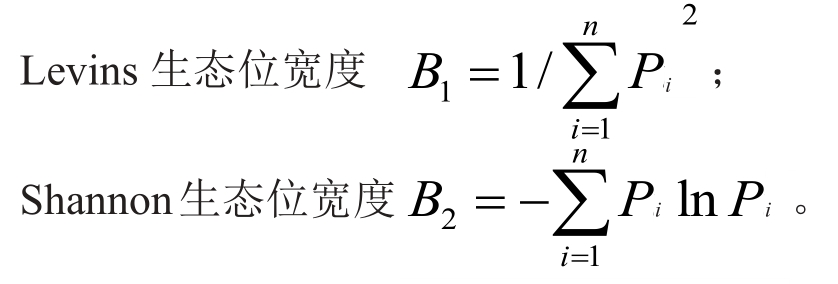
公式中,Pi为在一系统调查中物种在第i次调查所占比例。生态位宽度是生物所能利用的各种资源的总和。
生态优势度C=ni(ni-1)/[N(N-1)],N 为样方各物种的数量总和,ni为第i 个种的个体数量。当优势度>0.01时,该种即为优势种。
上述数据采用Microsoft Excel 2016 进行整理并制图,利用SPSS Statistics 21 软件进行Duncan’s法多重比较,所有样本数据均为3组重复。
2 结果与分析
2.1 苹果园草种群落组成
洛川县凤栖镇苹果园共有草种32 种(表1),分别隶属于15个科,其中草种种类最多的是禾本科和菊科,各占比19%;其次是豆科,占比9%;十字花科、蓼科、唇形科、藜科、茄科,占比均为6%;其他占比均为3%。另外,在果园附近发现的杂草还有刺儿菜、葎草、苜蓿草、尖裂假还阳参、黑麦草、早熟禾等,因其多生长在道路两旁并且数量极少,对果园土壤环境没有影响,故未做统计。
表1 洛川县凤栖镇苹果园草种组成
Table 1 Grass species composition in apple orchard in Fengqi town,Luochuan county
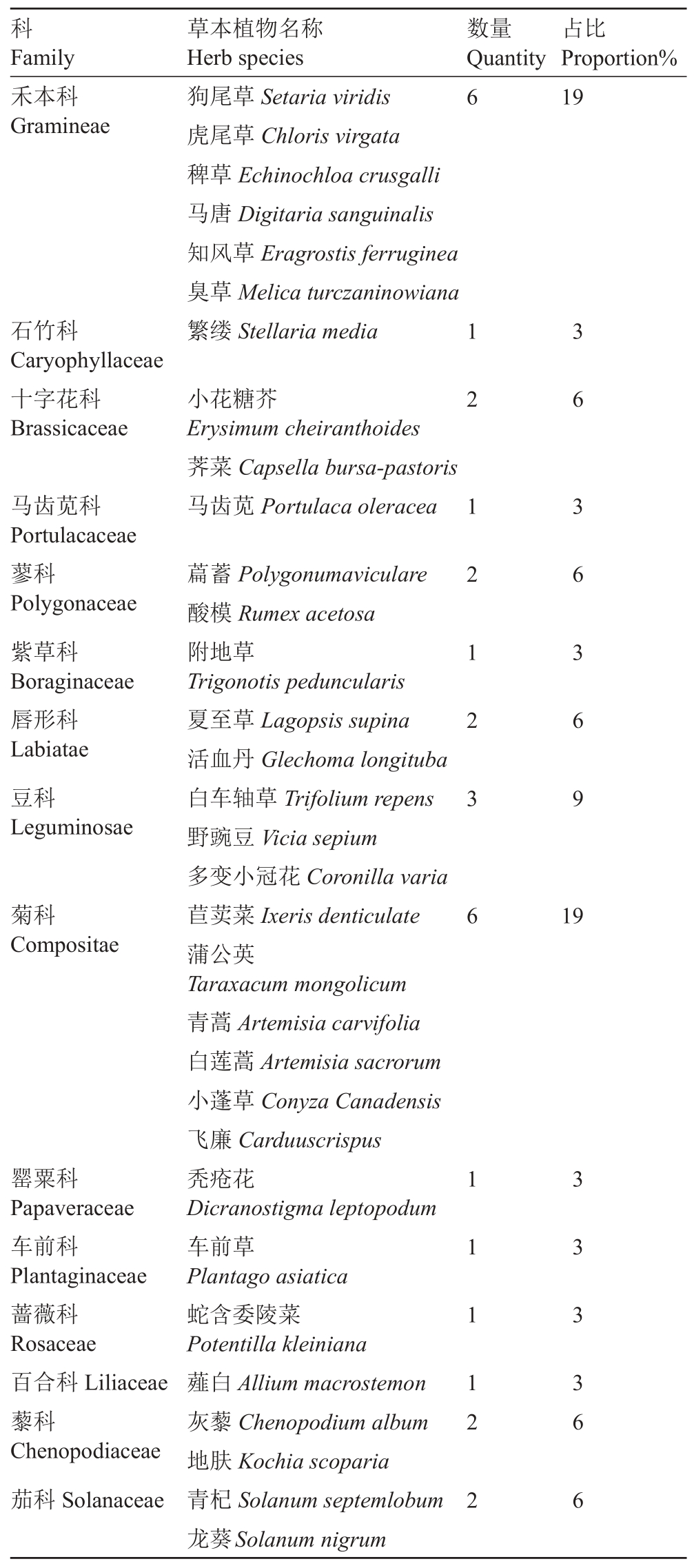
科Family禾本科Gramineae数量Quantity 6占比Proportion%19石竹科Caryophyllaceae十字花科Brassicaceae草本植物名称Herb species狗尾草Setaria viridis虎尾草Chloris virgata稗草Echinochloa crusgalli马唐Digitaria sanguinalis知风草Eragrostis ferruginea臭草Melica turczaninowiana繁缕Stellaria media马齿苋科Portulacaceae蓼科Polygonaceae紫草科Boraginaceae唇形科Labiatae豆科Leguminosae小花糖芥Erysimum cheiranthoides荠菜Capsella bursa-pastoris马齿苋Portulaca oleracea菊科Compositae 1 2 1 2 1 2 3 6 3 6 3 6 3 6 9 1 9罂粟科Papaveraceae车前科Plantaginaceae蔷薇科Rosaceae百合科Liliaceae藜科Chenopodiaceae茄科Solanaceae萹蓄Polygonumaviculare酸模Rumex acetosa附地草Trigonotis peduncularis夏至草Lagopsis supina活血丹Glechoma longituba白车轴草Trifolium repens野豌豆Vicia sepium多变小冠花Coronilla varia苣荬菜Ixeris denticulate蒲公英Taraxacum mongolicum青蒿Artemisia carvifolia白莲蒿Artemisia sacrorum小蓬草Conyza Canadensis飞廉Carduuscrispus秃疮花Dicranostigma leptopodum车前草Plantago asiatica蛇含委陵菜Potentilla kleiniana薤白Allium macrostemon灰藜Chenopodium album地肤Kochia scoparia青杞Solanum septemlobum龙葵Solanum nigrum 1 1 1 1 2 2 3 3 3 3 6 6
2.2 旱地苹果园中草本植物多样性指标随月份变化特点
调查8 个月的样方草本植物多样性指数如图1所示,物种丰富度9 月最高,4 月、5 月、7 月、11 月物种丰富度比较低,主要受天气变化影响,6月的草种多样性指数最低,其原因是农户因为田间作业进行了刈割,并且由于气温越来越高,直到7月的旱地苹果园温度达到全年最高值且降雨量少,影响了草被的生长,导致草被覆盖率相对较低。Simpson 指数显示,4 月、5 月、8 月、9 月、10 月指数大小变化小,生草覆盖率高,草密度较大,并且草在果园内分布均匀,4 月、5 月以荠菜和臭草为主,分布集中且均匀。8 月、9 月、10 月主要是狗尾草、虎尾草、马唐、稗草、繁缕、活血丹、薤白在果园中大量分布,均匀且稳定。
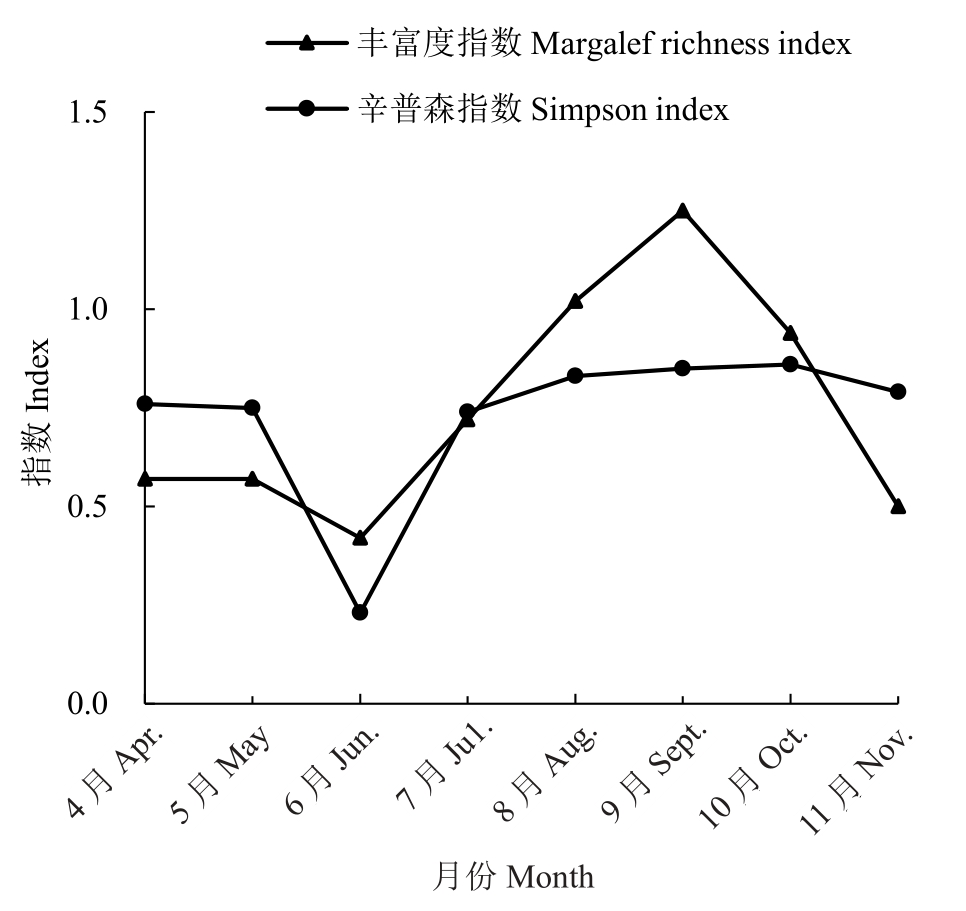
图1 凤栖镇苹果园中草本植物多样性指标变化特点
Fig.1 Variation characteristics of herbaceous plant diversity index in Fengqi apple orchard
2.3 旱地苹果园优势草种的生态位宽度
由表2 中的Levins 生态位宽度可以看出,蒲公英、蛇含委陵菜、青杞、苣荬菜、马唐、稗草、灰藜、荠菜、臭草、活血丹、虎尾草、薤白、狗尾草、繁缕生态位宽度数值依次减少,说明蒲公英、蛇含委陵菜、青杞植株相对高大,对不同生境资源的利用能力较强,而繁缕则对不同生境资源的利用能力较弱。由表2中Shannon 生态位宽度数值可以看出,繁缕、狗尾草、虎尾草的数值较大并依次减少,说明其在田间覆盖的时间较长,反之,蛇含委陵菜的覆盖时间较短。因为每种草种的Levins生态位宽度与Shannon生态位宽度数值大小排名不同,因此生态位宽度较大的种,不一定是群落的优势种,群落的优势种生态位宽度不一定最大。在这14个优势种中,生态位宽度较大的物种,对环境资源的利用能力较强;而没有列出的植物种的生态宽度较小,它们在该区分布范围较小,对该果园的生态环境适应性较差,长势较弱。因此,生态位宽度与物种本身的生理和生态适应性、竞争力、种间竞争强度、利用资源数量和分布空间等因素有关。
表2 凤栖镇苹果园优势草种的生态位宽度
Table 2 Niche width of dominant herb species in Fengqi apple orchard
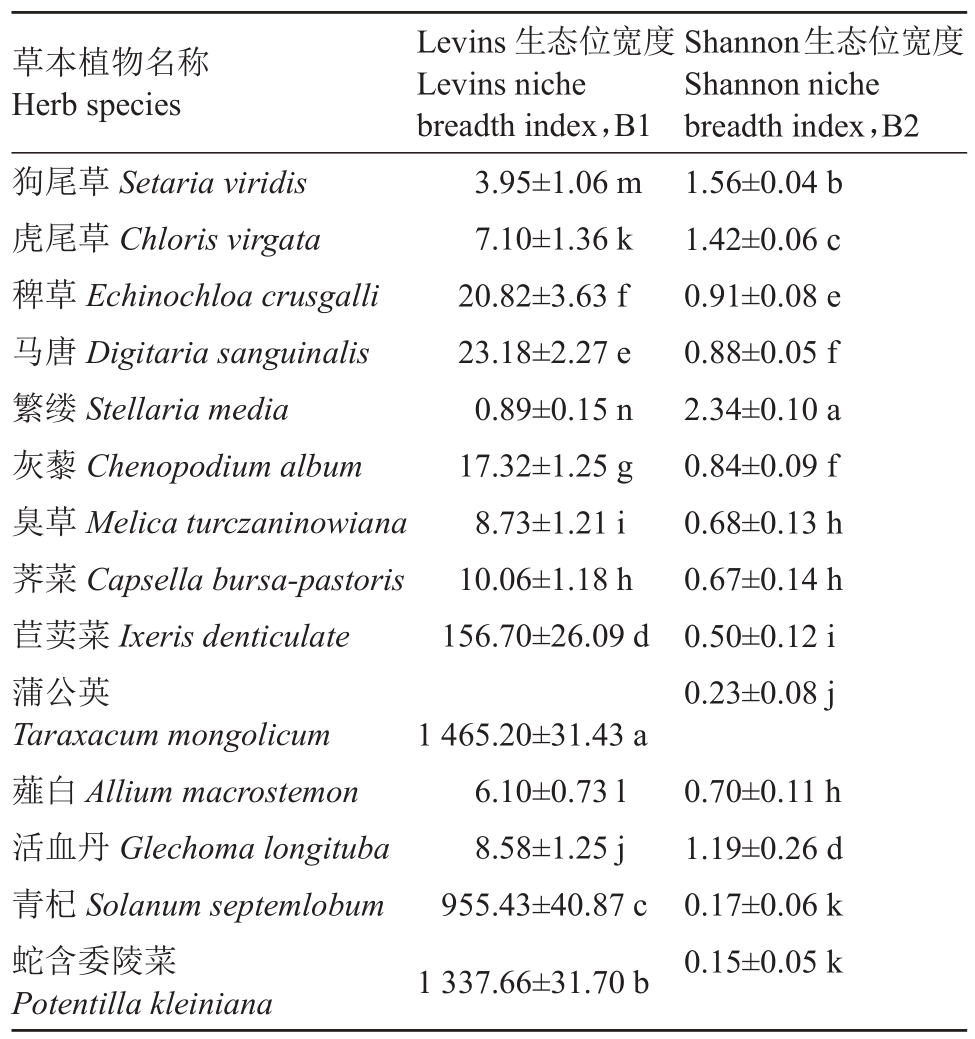
注:不同小写字母表示差异显著(p<0.05)。下同。
Note: Different small letters indicate significant difference at p<0.05.The same below.
草本植物名称Herb species狗尾草Setaria viridis虎尾草Chloris virgata稗草Echinochloa crusgalli马唐Digitaria sanguinalis繁缕Stellaria media灰藜Chenopodium album臭草Melica turczaninowiana荠菜Capsella bursa-pastoris苣荬菜Ixeris denticulate蒲公英Taraxacum mongolicum薤白Allium macrostemon活血丹Glechoma longituba青杞Solanum septemlobum蛇含委陵菜Potentilla kleiniana Levins 生态位宽度Levins niche breadth index,B1 3.95±1.06 m 7.10±1.36 k 20.82±3.63 f 23.18±2.27 e 0.89±0.15 n 17.32±1.25 g 8.73±1.21 i 10.06±1.18 h 156.70±26.09 d Shannon生态位宽度Shannon niche breadth index,B2 1.56±0.04 b 1.42±0.06 c 0.91±0.08 e 0.88±0.05 f 2.34±0.10 a 0.84±0.09 f 0.68±0.13 h 0.67±0.14 h 0.50±0.12 i 0.23±0.08 j 1 465.20±31.43 a 6.10±0.73 l 8.58±1.25 j 955.43±40.87 c 1 337.66±31.70 b 0.70±0.11 h 1.19±0.26 d 0.17±0.06 k 0.15±0.05 k
2.4 旱地苹果园中草本植物优势种组成
根据旱地苹果园草本植物的组成及出现频率等特点,主要筛选并计算14 个草种优势度,草种分别隶属于9 个科,其中繁缕、狗尾草、虎尾草全年的生长优势明显,其余草种的优势度会随着时间的变化而变化。旱地苹果园草本植物在4 月和5 月主要由石竹科、藜科、十字花科杂草组成,进入6 月十字花科、藜科杂草经人工干预彻底被取代和逐渐被取代,进入7月出现禾本科、唇形科杂草,并逐渐成为优势草种。8月、9月、10月伴随着降雨,杂草种类逐渐增多,以禾本科、石竹科、唇形科、百合科为主(表3)。
表3 凤栖镇苹果园全年各个月份的草种优势度
Table 3 The dominance of grass species in each month of the year in Fengqi apple orchard

草本植物名称Herb species狗尾草Setaria viridis虎尾草Chloris virgata稗草Echinochloa crusgalli马唐Digitaria sanguinalis繁缕Stellaria media灰藜Chenopodium album臭草Melica turczaninowiana荠菜Capsella bursa-pastoris苣荬菜Ixeris denticulate蒲公英Taraxacum mongolicum薤白Allium macrostemon活血丹Glechoma longituba青杞Solanum septemlobum蛇含委陵菜Potentilla kleiniana 4月Apr.5月May 6月Jun.7月Jul.0.121 40±0.012 00 a 0.055 87±0.007 78 a 0.103 22±0.007 93 a 0.027 62±0.005 27 c 0.055 98±0.002 28 b 0.049 72±0.000 39 b 0.001 64±0.000 56 d 0.000 15±0.000 05 d 0.109 76±0.007 34 a 0.027 70±0.006 07 a 0.058 52±0.004 46 a 0.049 63±0.001 54 a 0.000 81±0.000 32 a 0.000 08±0.000 00 a 0.758 98±0.060 52 a 0.002 14±0.000 36 b 0.034 93±0.003 61 a 0.000 03±0.000 13 a 8月Aug.0.046 86±0.002 72 b 0.014 41±0.001 55c 0.004 34±0.000 50 d 0.003 80±0.000 08 d 0.016 98±0.001 63 c 0.000 16±0.000 01 e 9月Sept.0.014 05±0.000 50 a 0.011 75±0.001 00 ab 0.006 19±0.001 37 b 0.005 64±0.002 58 b 0.022 59±0.000 60 ab 0.000 01±0.000 00 b 10月Oct.0.017 91±0.000 24 ab 0.015 80±0.000 57 ab 0.009 83±0.000 57 b 0.009 64±0.000 35 b 0.022 07±0.003 77 a 11月Nov.0.052 62±0.004 34 a 0.042 80±0.003 03 b 0.027 59±0.001 86 c 0.023 98±0.001 18 c 0.058 59±0.001 65 a 0.003 75±0.000 82 b 0.000 41±0.000 07 b 0.000 06±0.000 00 a 0.000 01±0.000 00 a 0.044 79±0.003 77 a 0.000 03±0.000 00 e 0.000 01±0.000 00 e 0.064 99±0.003 93 a 0.016 57±0.000 23 c 0.000 03±0.000 00 b 0.000 01±0.000 00 b 0.069 08±0.000 60 a 0.022 03±0.000 34 ab 0.000 56±0.000 05 b 0.000 41±0.000 07 b 0.029 66±0.001 61 ab 0.033 02±0.001 58 ab 0.000 48±0.000 04 b 0.000 33±0.000 05 b
2.5 旱地苹果园优势草种的相对高度
对于优势草种高度的测量,采取一月一测的方式,求得全年平均相对高度,对14 种草本植物的高度进行分析比较。如图2 所示,年平均相对高度较高的草种为蛇含委陵菜、青杞、灰藜、荠菜,年平均相对高度超过25 cm,草种高度过高,不利于改善旱地苹果园的生态环境,同时影响果园作业,应及时拔除。狗尾草、虎尾草、稗草、马唐、繁缕、苣荬菜、蒲公英、活血丹年平均相对高度在人为干预的条件下不超过25 cm,尤其繁缕可以覆盖8 个月,但生长高度均不超过15 cm,非常适合果园生草。
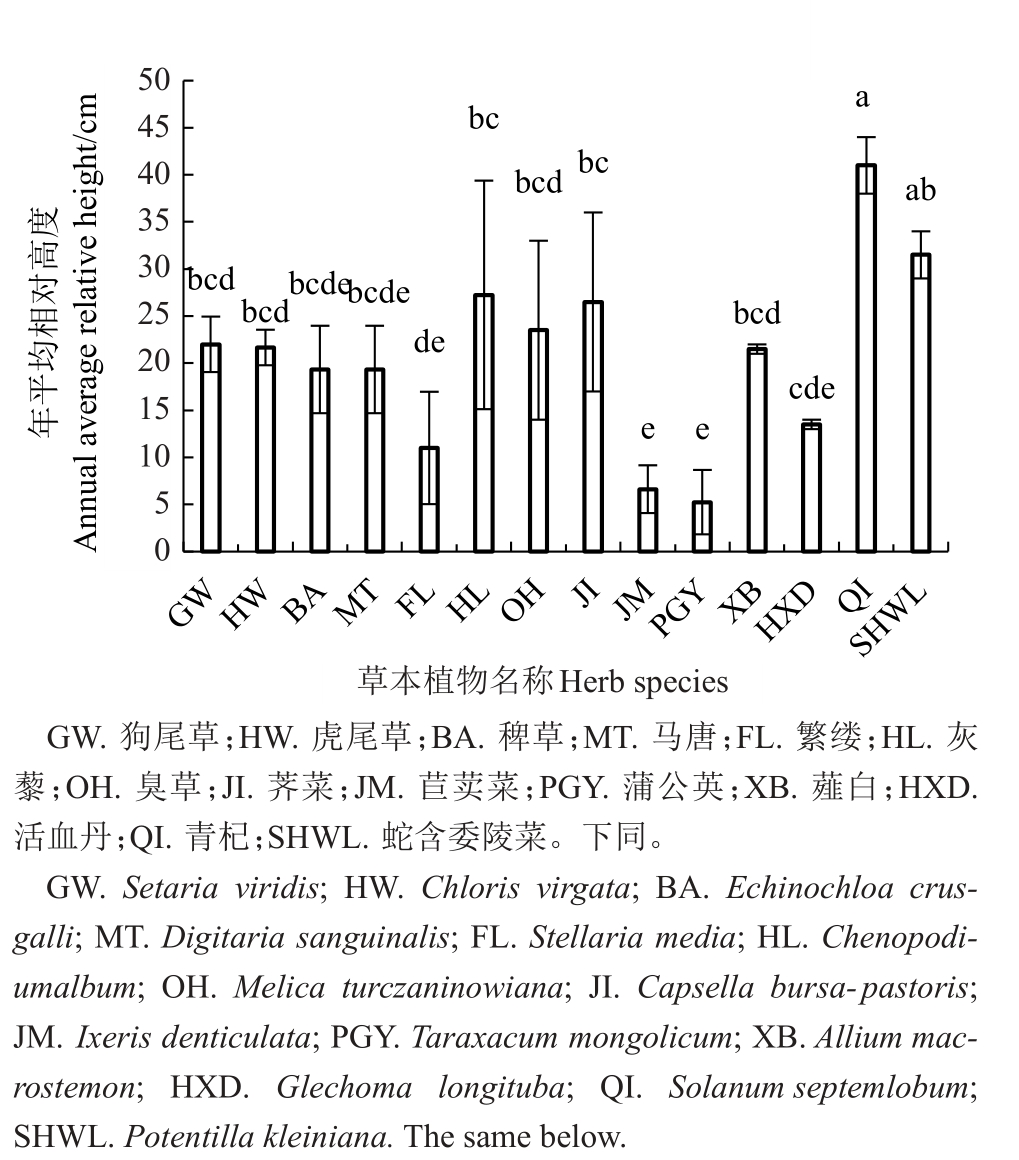
图2 凤栖镇苹果园优势草种的相对高度
Fig.2 Relative height of dominant herbaceous species in Fengqi apple orchard
2.6 旱地苹果园优势草本植物根系长度
植物的根系是吸收水分和矿物质的重要部位,因此草的根系扎入土壤越深,除了能够更好地固定植株本身外,更重要的是可以更好地吸收土壤中的营养,但是草根长得越长,越容易造成与果树的根系竞争营养和水分,所以根据旱地果园的特点,为有效避免水分及营养的竞争,要及时进行人工干预,留下根系较浅的草种,最好须根系发达,无主根,这样既可以促进土壤表面的团聚体形成,也可以优先避免水分竞争。因此,由图3 可以看出,狗尾草、虎尾草、稗草、马唐、繁缕、苣荬菜、蒲公英、薤白、活血丹都是可以留下的优势草种,尤其繁缕和活血丹须根发达,根系分布较浅,而灰藜和青杞要及时清除。
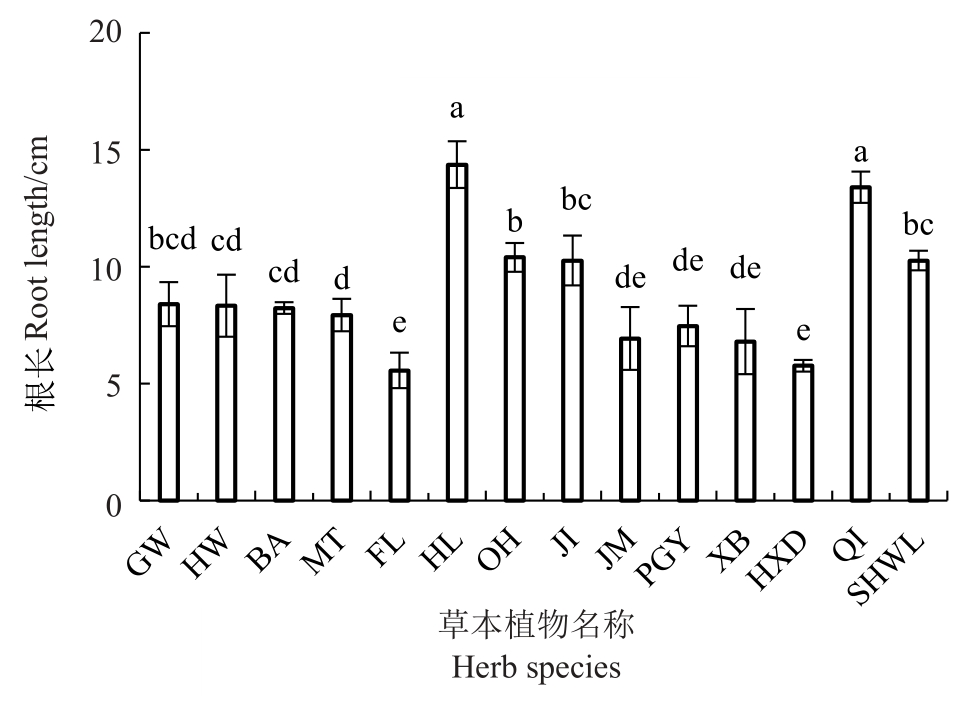
图3 凤栖镇苹果园优势草本植物的根系长度
Fig.3 Root length of dominant herbaceous plants in Fengqi apple orchard
3 讨 论
随着发展绿色农业的理念深入人心,果园自然生草的土壤管理模式也变得越来越普遍,很多报道说明果园采用自然生草管理对调节果园生态环境有重要作用[14-16]。筛选合适的草种在自然生草土壤管理中是最关键的环节,适宜的草种可以减少草被刈割次数,降低果园土壤管理成本,但是草种选择不适则会起到反作用[17]。因此选择合适的自然草种进行果园生草处理不仅可以降低劳动成本,而且在改善土壤结构和果园生态环境以及提高果实品质和产量方面效果也尤为明显[18]。
研究发现,果园生草的效果主要取决于园内自然草种的选择[19]。在本试验中,繁缕非常适用于果园自然生草,因其具有植株低矮,覆盖时间长,覆盖密度均匀稳定,并且无主根,须根发达且分布较浅,抗性强的特点,繁缕生草可以显著减少果园刈割次数,这与郝燕燕等[8]的研究结果完全相同。生长特性、覆盖时间(绿期)、覆盖密度、草种产量等都是评价草种质量的重要指标。一般认为,草种须根系越发达,土壤微生物结构越丰富;覆盖时间越长,草的生命力越强;覆盖密度越大,生长量就越大,对于提高土壤有机质含量更有利,并且草种叶片细长更适合应用于果园生草[20],这在本试验中也得到了验证,笔者在本试验中筛选出的狗尾草、虎尾草、马唐、稗草、繁缕、蒲公英、苣荬菜、活血丹均符合全年覆盖地表时间长且覆盖密度大、耐旱、根系浅、生长需水量少和抗性强的特点。因此旱区果园选取的自然生草草种不宜有主根,须根系发达且根长不宜超过10 cm,否则草种生长需水量增加,并且植株低矮,最高不超过30 cm,不影响果园作业,草种耐阴,耐踩踏,同时不存在与果树共生的病虫害。
果园自然生草管理逐渐被人们接受,但在管理前期仍需要人工长时间的干预,不断地将选择好的良性草种留下,拔除有攀援性、植株高大、有主根且根系长、覆盖周期短、有特殊分泌物会影响周边其他生物生长的草种,例如:灰藜长势迅速,主根系长且容易木质化;小蓬草根系会分泌特殊物质影响周围植物生长;青杞植株高大,影响果园作业等,此类草种都应及时拔除。在进行一至多个生长周期的草种筛选后,草种群落结构会逐渐稳定,在除草方面人工投入会减少,并且长期的生草管理有利于土壤环境的改善。从目前已有的研究结果来看,生草会与果树争肥这一观点仍存在争议,Monteiro 等[21]的试验证明生草可明显降低树体生长势,尤其是幼树,全园生草使树体生长减弱是由于草对水分的过度竞争,但当水分供应充足时,这种竞争就会减弱。同时,进行刈割处理也会有效缓解生草争水争肥的现象。果园自然生草草种选择需慎重,笔者在本试验中仅对当地原有草种进行大田试验,筛选出可以作为果园自然生草的草种,并且果园生草对果树生长发育和土壤环境有明显改善(该数据未发表),但果园生草处理是否会加重果树病虫害还有待进一步研究。
4 结 论
果园的自然生草种类会随着季节变化而变化,在人工干预下要确保留下的草种具有覆盖密度大、抗性强、根系浅的基本特性,在今后的研究中可以考虑进一步分析在留下的草种中,其根系分泌物对草种和土壤的影响。
[1]ENDA Z,MINGCHUAN G,BO Y,CHAO S,JIALI H,SIJUN Q,DEGUO L.Effects of mowing dominant grasses on root exudation and soil nitrogen cycling in a natural sod culture apple orchard[J].Plant,Soil and Environment,2021,67(10):567-578.
[2]YANG J K,DUAN Y M,WU X P,TIAN Y L,YANG L,ZHANG Y Y,LIU Z Z,AWASTHI M K,LI H K. Long-term grass mulching waste recycling and evaluation activation of dissolved organic carbon[J/OL]. Chemosphere,2022,287(P4):132454.DOI:10.1016/j.chemosphere.2021.132454.
[3]白岗栓,周楠,邵发琦,杜建会,郭江平.自然生草对渭北旱塬苹果园土壤氮及果实品质的影响[J].农业工程学报,2021,37(10):100-109.BAI Gangshuan,ZHOU Nan,SHAO Faqi,DU Jianhui,GUO Jiangping. Effects of self-sown grass on soil nitrogen and apple fruit quality in the Weibei dry plateau[J].Transactions of the Chi-nese Society of Agricultural Engineering,2021,37(10):100-109.
[4]唐笑天.陕西苹果产业发展存在问题及对策建议[J].果农之友,2015(2):3-4.TANG Xiaotian.Problems and countermeasures of Shaanxi apple industry development[J].Fruit Growers’Friend,2015(2):3-4.
[5]段凯,孟伟东.陕西洛川苹果产业现状[J].农业工程,2020,10(7):126-128.DUAN Kai,MENG Weidong.Current situation of Luochuan apple industry in Shaanxi[J]. Agricultural Engineering,2020,10(7):126-128.
[6]李志熙,白岗栓,邹超煜,邵发琦.自然生草对渭北旱塬苹果园土壤孔隙和水分入渗的影响[J].中国农业大学学报,2022,27(5):146-156.LI Zhixi,BAI Gangshuan,ZOU Chaoyu,SHAO Faqi.Effects of self-sown grass on soil porosity and soil infiltration in apple orchard in Weibei dry plateau[J]. Journal of China Agricultural University,2022,27(5):146-156.
[7]雷虹,张战利,文耀东. 陕西省苹果园杂草发生情况调查初报[J].杂草科学,2005,23(4):26-27.LEI Hong,ZHANG Zhanli,WEN Yaodong. Preliminary report on weed occurrence in apple orchard of Shaanxi province[J].Weed Science,2005,23(4):26-27.
[8]郝燕燕,赵旗峰. 适合果园生草的草种:繁缕[J]. 山西果树,2016(1):52-53.HAO Yanyan,ZHAO Qifeng. Grass suitable for orchard grass:Zoysia[J].Shanxi Fruits,2016(1):52-53.
[9]李芳东,吕德国,于云政,徐田伟,杜国栋,秦嗣军.果园生草试验及适生草种评价[J].北方果树,2012(6):9-11.LI Fangdong,LÜ Deguo,YU Yunzheng,XU Tianwei,DU Guodong,QIN Sijun. Orchard grass cultivation experiment and adaptable forages evaluation[J].Northern Fruits,2012(6):9-11.
[10]刘朝红,胡增丽,张未仲,赵龙龙.桃园草本植物群落短期演替特点研究[J].内蒙古农业大学学报(自然科学版),2021,42(6):5-9.LIU Chaohong,HU Zengli,ZHANG Weizhong,ZHAO Longlong. Characteristics of short-term succession of herbaceous plant communities in peach orchard[J]. Journal of Inner Mongolia Agricultural University (Natural Science Edition),2021,42(6):5-9.
[11]陈翠霞,刘占军,陈竹君,霍百全,周建斌.黄土高原新老苹果产区施肥现状及土壤肥力状况评价[J]. 土壤通报,2018,49(5):1144-1149.CHEN Cuixia,LIU Zhanjun,CHEN Zhujun,HUO Baiquan,ZHOU Jianbin. Evaluating the situation of fertilization and soil fertility in new and old apple orchards of the Loess Plateau[J].Chinese Journal of Soil Science,2018,49(5):1144-1149.
[12]李柳莹,王延平,韩明玉,张林森,穆艳.洛川苹果园土壤的理化特征分析[J].西北农林科技大学学报(自然科学版),2016,44(4):185-194.LI Liuying,WANG Yanping,HAN Mingyu,ZHANG Linsen,MU Yan. Physical and chemical properties of soil in apple orchards of Luochuan[J]. Journal of Northwest A & F University(Natural Science Edition),2016,44(4):185-194.
[13]白晓航,张金屯.小五台山森林群落优势种的生态位分析[J].应用生态学报,2017,28(12):3815-3826.BAI Xiaohang,ZHANG Jintun.Niche analysis of dominant species of forest community in Xiaowutai Mountain,China[J]. Chinese Journal of Applied Ecology,2017,28(12):3815-3826.
[14]PALESE A M,VIGNOZZI N,CELANO G,AGNELLI A E,PAGLIAI M,XILOYANNIS C. Influence of soil management on soil physical characteristics and water storage in a mature rainfed olive orchard[J].Soil&Tillage Research,2014,144:96-109.
[15]付学琴,杨星鹏,陈登云,甘燕云,黄文新.南丰蜜橘果园生草栽培对土壤团聚体和有机碳特征及果实品质的影响[J].园艺学报,2020,47(10):1905-1916.FU Xueqin,YANG Xingpeng,CHEN Dengyun,GAN Yanyun,HUANG Wenxin. Effects of sod culture on soil aggregates,organic carbon characteristic and fruit quality of Nanfeng tangerine orchard[J]. Acta Horticulturae Sinica,2020,47(10):1905-1916.
[16]TAGUAS E V,PEÑA A,AYUSO J L,PÉREZ R,YUAN Y,GIRÁLDEZ J V. Rainfall variability and hydrological and erosive response of an olive tree microcatchment under no-tillage with a spontaneous grass cover in Spain[J]. Earth Surface Processes and Landforms,2010,35:750-760.
[17]黄金辉,廖允成,高茂盛.耕作和覆盖对黄土高原果园土壤水分和温度的影响[J].应用生态学报,2009,20(11):2652-2658.HUANG Jinhui,LIAO Yuncheng,GAO Maosheng. Effects of tillage and mulching on orchard soil moisture content and temperature in Loess Plateau[J]. Chinese Journal of Applied Ecology,2009,20(11):2652-2658.
[18]杨露,毛云飞,胡艳丽,王芸芸,张璐璐,尹伊君,庞会灵,宿夏菲,刘业萍,沈向.生草改善果园土壤肥力和苹果树体营养的效果[J].植物营养与肥料学报,2020,26(2):325-337.YANG Lu,MAO Yunfei,HU Yanli,WANG Yunyun,ZHANG Lulu,YIN Yijun,PANG Huiling,SU Xiafei,LIU Yeping,SHEN Xiang.Effects of orchard grass on soil fertility and apple tree nutrition[J]. Journal of Plant Nutrition and Fertilizers,2020,26(2):325-337.
[19]ALLEY J L,GARRETT H E,MCGRAW R L,DWYER J P,BLANCHE C A. Forage legumes as living mulches for trees in agroforestry practices-preliminary results[J]. Agroforestry Systems,1999,44(2/3):281-291.
[20]杨露,毛云飞,张佳腾,张璐璐,王芸芸,尹伊君,刘业萍,宿夏菲,庞会灵,胡艳丽.果园生草优良草种的初步筛选[J].山东农业科学,2019,51(7):96-102.YANG Lu,MAO Yunfei,ZHANG Jiateng,ZHANG Lulu,WANG Yunyun,YIN Yijun,LIU Yeping,SU Xiafei,PANG Huiling,HU Yanli. Preliminary screening of fine grass species for orchard[J].Shandong Agricultural Sciences,2019,51(7):96-102.
[21]MONTEIROA,LOPES C M.Influence of cover crop on water use and performance of vineyard in Mediterranean Portugal[J].Agriculture,Ecosystems and Environment,2007,121(4):336-342.